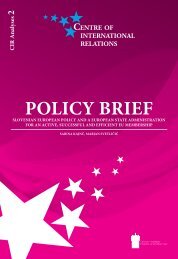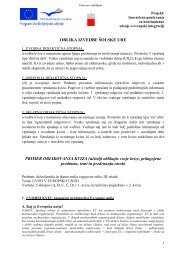national system of innovation in slovenia - Mednarodni odnosi
national system of innovation in slovenia - Mednarodni odnosi
national system of innovation in slovenia - Mednarodni odnosi
You also want an ePaper? Increase the reach of your titles
YUMPU automatically turns print PDFs into web optimized ePapers that Google loves.
13<br />
1. INTRODUCTION<br />
In economic theory as well as <strong>in</strong> policy the importance <strong>of</strong> <strong><strong>in</strong>novation</strong> as one <strong>of</strong> the<br />
key determ<strong>in</strong>ants <strong>of</strong> long-run economic growth is widely recognized. The concepts<br />
like <strong>national</strong> <strong><strong>in</strong>novation</strong> <strong>system</strong> (NIS) (Edquist 1997) and <strong>national</strong> <strong>in</strong>novative<br />
capacity as the ability <strong>of</strong> a country to produce and commercialize a flow <strong>of</strong><br />
<strong>in</strong>novative technology over the long term (Furman et al. 2002) receive significant<br />
attention. In its ambition to secure the country long-term susta<strong>in</strong>able economic<br />
and social development, Slovenia is look<strong>in</strong>g also at the <strong>national</strong> <strong><strong>in</strong>novation</strong> <strong>system</strong><br />
<strong>in</strong> an attempt to develop R&D and <strong><strong>in</strong>novation</strong> capacities as important sources and<br />
determ<strong>in</strong>ants <strong>of</strong> economic growth.<br />
Slovenian <strong><strong>in</strong>novation</strong> <strong>system</strong> has over the years evolved through complex relationship<br />
<strong>of</strong> relatively <strong>in</strong>fluential public R&D sector, <strong>in</strong>creas<strong>in</strong>g presence <strong>of</strong> bus<strong>in</strong>ess<br />
as the key <strong>in</strong>vestor <strong>in</strong> R&D and <strong><strong>in</strong>novation</strong> and a search for optimal governance<br />
<strong>of</strong> <strong><strong>in</strong>novation</strong> policy, also by look<strong>in</strong>g at best practices <strong>in</strong> other countries. A<br />
survey <strong>of</strong> the exist<strong>in</strong>g <strong>system</strong>, with particular attention to the policy options, is<br />
especially useful and timely, s<strong>in</strong>ce Slovenia needs to prepare some <strong>of</strong> its critical<br />
policy documents <strong>in</strong> the area <strong>of</strong> NIS, like the National Programme for Research<br />
and Development, National Programme for Higher Education as well as the correspond<strong>in</strong>g<br />
legislation (Law on R&D as well as Law on Higher Education).<br />
The analysis looks at the NIS through the concept <strong>of</strong> <strong>national</strong> <strong>in</strong>novative capacity<br />
(Furman et al. 2002) and tries to capture the current state <strong>of</strong> affairs <strong>in</strong> all ma<strong>in</strong><br />
areas, which build such capacity. First, <strong>national</strong> <strong>in</strong>novative capacity depends on the<br />
presence <strong>of</strong> a strong common <strong><strong>in</strong>novation</strong> <strong>in</strong>frastructure: country’s overall science<br />
and technology capabilities and policy environment and the mechanisms <strong>in</strong> place<br />
for support<strong>in</strong>g basic research and higher education. Thus, the analysis presents the<br />
basic data on R&D and <strong><strong>in</strong>novation</strong> and provides for the overview <strong>of</strong> the ma<strong>in</strong> actors<br />
<strong>in</strong> Slovenian NIS: from bus<strong>in</strong>ess sector R&D and <strong><strong>in</strong>novation</strong> activity to public<br />
R&D at the higher education <strong>in</strong>stitutions (HEI) and public research <strong>in</strong>stitutes. Not<br />
only is the capacity <strong>of</strong> each actor important, the l<strong>in</strong>kages with<strong>in</strong> NIS are seen more<br />
and more as detrimental for the successful <strong><strong>in</strong>novation</strong> policy. S<strong>in</strong>ce the closer cooperation<br />
between public science and <strong>in</strong>dustry is seen as one <strong>of</strong> the important ways<br />
to improve effectiveness <strong>of</strong> the NIS on one hand and s<strong>in</strong>ce the <strong>in</strong>sufficient l<strong>in</strong>kages<br />
between bus<strong>in</strong>ess sector and public R&D has <strong>of</strong>ten been s<strong>in</strong>gled out as one <strong>of</strong> the<br />
ma<strong>in</strong> challenges for the Slovenian NIS (PRO INNO Trendchart Country report on<br />
Slovenia 2008 and 2009), a special section <strong>of</strong> the analysis focuses on this issue.<br />
The role <strong>of</strong> public policy <strong>in</strong> build<strong>in</strong>g the <strong><strong>in</strong>novation</strong> capabilities <strong>of</strong> the ma<strong>in</strong> actors<br />
is also very important. The structure <strong>of</strong> STI policy governance as well as policy





